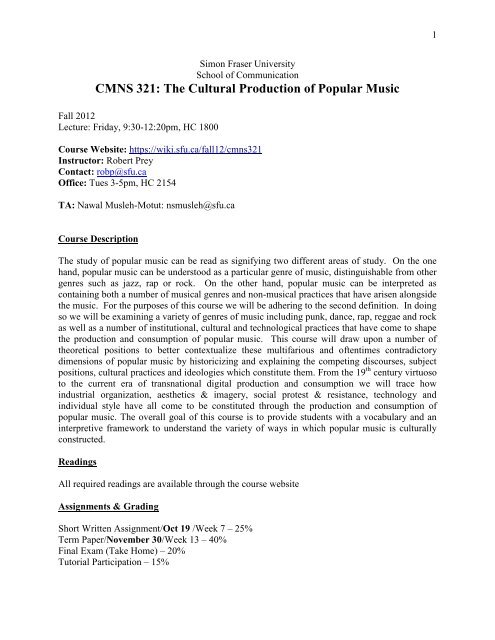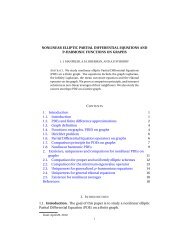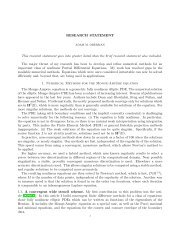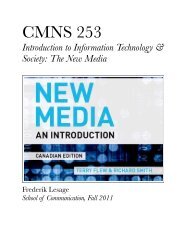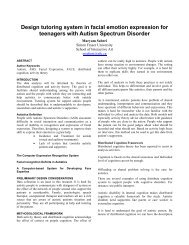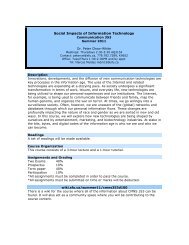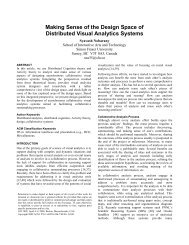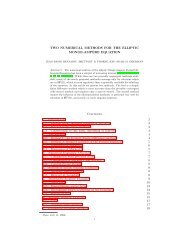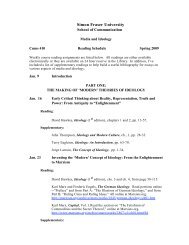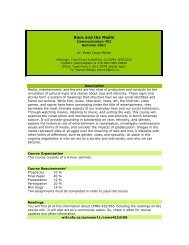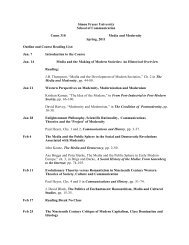Simon Fraser University - SFU Wiki
Simon Fraser University - SFU Wiki
Simon Fraser University - SFU Wiki
You also want an ePaper? Increase the reach of your titles
YUMPU automatically turns print PDFs into web optimized ePapers that Google loves.
1<br />
<strong>Simon</strong> <strong>Fraser</strong> <strong>University</strong><br />
School of Communication<br />
CMNS 321: The Cultural Production of Popular Music<br />
Fall 2012<br />
Lecture: Friday, 9:30-12:20pm, HC 1800<br />
Course Website: https://wiki.sfu.ca/fall12/cmns321<br />
Instructor: Robert Prey<br />
Contact: robp@sfu.ca<br />
Office: Tues 3-5pm, HC 2154<br />
TA: Nawal Musleh-Motut: nsmusleh@sfu.ca<br />
Course Description<br />
The study of popular music can be read as signifying two different areas of study. On the one<br />
hand, popular music can be understood as a particular genre of music, distinguishable from other<br />
genres such as jazz, rap or rock. On the other hand, popular music can be interpreted as<br />
containing both a number of musical genres and non-musical practices that have arisen alongside<br />
the music. For the purposes of this course we will be adhering to the second definition. In doing<br />
so we will be examining a variety of genres of music including punk, dance, rap, reggae and rock<br />
as well as a number of institutional, cultural and technological practices that have come to shape<br />
the production and consumption of popular music. This course will draw upon a number of<br />
theoretical positions to better contextualize these multifarious and oftentimes contradictory<br />
dimensions of popular music by historicizing and explaining the competing discourses, subject<br />
positions, cultural practices and ideologies which constitute them. From the 19 th century virtuoso<br />
to the current era of transnational digital production and consumption we will trace how<br />
industrial organization, aesthetics & imagery, social protest & resistance, technology and<br />
individual style have all come to be constituted through the production and consumption of<br />
popular music. The overall goal of this course is to provide students with a vocabulary and an<br />
interpretive framework to understand the variety of ways in which popular music is culturally<br />
constructed.<br />
Readings<br />
All required readings are available through the course website<br />
Assignments & Grading<br />
Short Written Assignment/Oct 19 /Week 7 – 25%<br />
Term Paper/November 30/Week 13 – 40%<br />
Final Exam (Take Home) – 20%<br />
Tutorial Participation – 15%
2<br />
Overview of Assignments & Exams<br />
Short Written Assignment: Due Oct 19 —25%<br />
1500-1750 Words<br />
This assignment is intended to prepare you for the term paper by asking you to engage critically<br />
with some aspect of musical culture by applying ideas drawn from the readings we cover in the<br />
first half of the semester.<br />
Term Paper: Due Nov. 30—40%<br />
3000-4000 Words<br />
The term paper is the major component of the course. Thus, it is important to begin thinking<br />
about potential topics, directions or debates that interest you and begin to formulate ideas quite<br />
early on in the semester in order to properly situate yourself with relevant research material. A<br />
good place to begin (other than course readings) is to review the articles in various journals that<br />
deal with popular music (Journal of Popular Music Studies, Popular Music, Popular Music &<br />
Society) Please take advantage of office hours to talk about the ideas you’ve been thinking about<br />
and to receive feedback and suggestions for further research.<br />
Final Exam—20%<br />
The final exam will be a take home exam. The questions will be handed out at the last lecture<br />
and will also available on the course website after this lecture.<br />
Tutorial Participation—15%<br />
Tutorial participation is based upon both attendance and participation in tutorials. Your TA will<br />
speak to this during the first tutorial.<br />
Late Assignments<br />
Late assignments are penalized 5% per day late (including weekends). Please speak to your TA<br />
if an extension is required. Barring exceptional circumstances, absolutely no extensions will be<br />
given 24 hours prior to the due date of any assignment.<br />
Schedule of Lectures and Readings<br />
Week 1<br />
Sept 7: Studying the Cultural Production of Popular Music<br />
<strong>Simon</strong> Frith (1987) “Towards an Aesthetic of Popular Music” in Music & Society: The<br />
Politics of Composition, Performance and Reception, eds. Leppert & McClary.<br />
(Cambridge: Cambridge <strong>University</strong> Press), 133-151.
3<br />
Week 2<br />
Sept 14: The Pre-History of Popular Music - Music Becomes a Commodity<br />
Tim Blanning (2008) The Triumph of Music: The Rise of Composers, Musicians, and<br />
Their Art (Cambridge: Belknap Press), 7-17; 30-45; 51-57.<br />
Jacques Attali (1985) Noise: The Political Economy of Music, trans. Brian Massumi<br />
(Minneapolis: <strong>University</strong> of Minnesota Press), 3-21; 46-55.<br />
Suggested Readings<br />
Weber, W. (2004[1975]). Music & the Middle Class: The Social Structure of Concert Life in London,<br />
Paris and Vienna Between 1830-1848. Burlington, VT.: Ashgate.<br />
Johnson, J. (1995). Listening in Paris: A Cultural History. Berkeley: <strong>University</strong> of California Press.<br />
Michael Chanan (1994). Music Practica: The Social Practice of Western Music from Gregorian<br />
Chant to Postmodernism. London: Verso, pp. 138-161.<br />
Week 3<br />
Sept 21: Popular Music & The Recording Industry<br />
<strong>Simon</strong> Frith (1987) “The Industrialization of Popular Music” in Popular Music and<br />
Communication ed. J. Lull (Newbury Park, CA: Sage), 53-78.<br />
Reebe Garofalo (1999) “From Music Publishing to mp3: Music and Industry in the 20 th<br />
Century,” American Music, 17 no.3: 318-354.<br />
Kembrew McLeod (2005) “mp3s are Killing Home Taping: The Rise of Internet<br />
Distribution and Its Challenge to the Major Label Music Monopoly,” Popular Music &<br />
Society, 28 no.4: 521-531.<br />
Suggested Readings<br />
Hull, Geoffrey P. (2004). The Recording Industry. New York: Routledge.<br />
Mike Hobart (1981). “The Political Economy of Bop.” Media, Culture and Society, 3, pp. 261-279.<br />
Qureshi, R.B. (2002). Music and Marx: Ideas, Practice, Politics. New York: Routledge.<br />
Frith, S. & Marshall, L. (2004). Music & Copyright. New York: Routledge.<br />
Week 4<br />
Sept 28: Theorizing Popular Music - The Frankfurt School & Mass Culture Critique<br />
Theodor W. Adorno (2002 [1941]) “On Popular Music,” in Essays on Music. (Berkeley:<br />
<strong>University</strong> of California Press, 437-469.<br />
Theodor W. Adorno (1991 [1938]) “On the Fetish Character in Music and the Regression<br />
of Listening,” in The Culture Industry: Selected Essays on Mass Culture (New York:<br />
Routledge, 29-61.<br />
Suggested Readings<br />
Walter Benjamin (1968) “The Work of Art in the Age of Mechanical Reproduction” in Illuminations, pp.<br />
217-252.<br />
Theodor W. Adorno. (2002) Essays on Music ed. Richard Leppert. Berkeley: <strong>University</strong> of California<br />
Press.<br />
Richard Leppert (2005). “Music Pushed to the Edge of Existence (Adorno, Listening and the Question of<br />
Hope).” Critical Inquiry 60, pp. 92-133.<br />
Tia DeNora (2003). After Adorno: Rethinking Music Sociology. Cambridge: Cambridge <strong>University</strong> Press.
4<br />
Week 5<br />
Oct 5: Theorizing Popular Music - Subcultures<br />
Dick Hebdige (1979) Subculture: The Meaning of Style. New York: Routledge, 1-29;<br />
73-127.<br />
Suggested Readings<br />
Sarah Thornton (1995). “Club Cultures: Music, Media and Subcultural Capital.” Cambridge: Polity Press.<br />
Gelder, K. (2005). The Subcultures Reader. New York: Routledge.<br />
Will Straw (1991). “Systems of Articulation, Logics of Change: Communities and Scenes in Popular<br />
Music.” Cultural Studies, 5(3), pp.368-388.<br />
Week 6<br />
Oct 12: Theorizing Popular Music – The Specter of Authenticity & Selling Out<br />
Michael Coyle and Jon Doyle (1999) “Modeling Authenticity, Authenticating Commercial<br />
Models” in Reading Rock and Roll: Authenticity, Appropriation and Aesthetics, ed.<br />
Dettmer & Richey (New York: Columbia <strong>University</strong> Press), 17-35.<br />
Frith, S. (1986). “Art versus Technology: The Strange Case of Popular Music,” Media,<br />
Culture, and Society, 8: 263-279.<br />
Peterson, Richard A. (2005). “In Search of Authenticity.” Journal of Management<br />
Studies, 42(5), pp.1083-1098.<br />
Suggested Readings<br />
Hesmondhalgh, D. (1999). “Indie: The Institutional Politics and Aesthetics of a Popular Music Genre.”<br />
Cultural Studies 13 (1), pp. 34-61.<br />
Elizabeth Eva Leach (2001) “Vicars of ‘Wannabe’: Authenticity and the Spice Girls.” Popular Music<br />
20(2), pp.143-167.<br />
Allan Moore (2002). “Authenticity as Authentication.” Popular Music 21(2) pp. 209-223.<br />
Tichi, C. (1998). Reading Country Music: Steel Guitars, Opry Stars, and Honky-Tonk Bars. Durham:<br />
Duke <strong>University</strong> Press.<br />
Mark Mazullo, “The Man Whom the World Sold: Kurt Cobain, Rock’s Progressive Aesthetic, and the<br />
Challenges of Authenticity,” The Music Quarterly, 84 no.4 (2000): 713-1749.<br />
Week 7<br />
*****SHORT WRITING ASSIGNMENT DUE******<br />
Oct 19: The Sight of Sound<br />
Victor P Corona. (2011) Memory, Monsters, and Lady Gaga. The Journal of Popular<br />
Culture, 44(2): 1-19.<br />
Graham Carr (2006) “Visualizing ‘The Sound of Genius’: Glenn Gould and the Culture<br />
of Celebrity in the 1950s.” Journal of Canadian Studies 40 (3), pp. 5-42.<br />
Fabian Holt (2011) Is Music Becoming More Visual Online Video Content in the Music<br />
Industry, Visual Studies, 26:1, 50-61.<br />
Suggested Readings<br />
P. Auferheide. (1986). “Music videos: The look of the sound” Journal of Communication,<br />
36, 57–77.<br />
Douglas Kellner (1995) “Madonna, Fashion & Image” in Media Culture. New York:<br />
Routledge, pp. 263-297.
5<br />
Week 8<br />
Oct 26: Globalization & Musical Culture I - Jamaica: Trench Town meets Babylon<br />
Hebdige, D. (1987). Cut ‘n’ Mix: Culture, Identity and Caribbean Music. London:<br />
Methuen & Co. pp. 47-102 & 136-148.<br />
Michelle A. Stephens (1998) “Babylon’s ‘Natural Mystic’: The North American Music<br />
Industry, the Legend of Bob Marley, and the Incorporation of Transnationalism.”<br />
Cultural Studies 12(2), pp. 139-167.<br />
Week 9<br />
Nov 2: Globalization & Musical Culture II - South Korea: Chosun Punk & K-Pop<br />
Stephen Epstein. (2000) “Anarchy in the UK, Solidarity in the ROK: Punk Rock Comes<br />
to Korea” Acta Koreana 3.<br />
Hyunjoon Shin (2009) “Have you ever seen the Rain And who’ll stop the Rain: the<br />
globalizing project of Korean pop (K‐pop)”, Inter-Asia Cultural Studies, 10:4, 507-523<br />
Sun Jung (2012). "Fan Activism, Cybervigilantism, and Othering Mechanisms in K-pop<br />
Fandom." In "Transformative Works and Fan Activism," edited by Henry Jenkins and<br />
Sangita Shresthova, special issue, Transformative Works and Cultures, no. 10. Available<br />
from: http://journal.transformativeworks.com/index.php/twc/article/view/300/287<br />
Suggested Readings<br />
Keith Howard, (ed.) (2006) Korean Pop: Riding the Wave. Kent, England: Global Oriental, 2006. pp.21-<br />
33.<br />
Doobo Shim. (2006) “Hybridity and the rise of Korean popular culture in Asia” Media<br />
Culture Society. vol. 28 no. 1<br />
Yeran Kim. (2011) “Idol republic: the global emergence of girl industries and the commercialization of girl<br />
bodies”. Journal of Gender Studies. Vol 20, Issue 4.<br />
Week 10<br />
Nov 9: Music From the Margins I – Riot Grrrls & Disco<br />
Angela McRobbie (1990[1980]). “Settling Accounts with Subcultures: A Feminist<br />
Critique” in Frith & Goodwin (eds.) On Record: Rock, Pop, and the Written<br />
Word. New York: Pantheon Books, pp. 66-81.<br />
Schilt, K. (2003). “A Little Too Ironic: The Appropriation and Packaging of Riot Grrrl<br />
Politics by Mainstream Female Musicians.” Popular Music & Society 26(1), pp. 5-16.<br />
Kai Fikentscher (2000) You Better Work: Underground Dance Music in New York City.<br />
Hanover NH: <strong>University</strong> Press of New England. pp. 3-19, 93-108.<br />
Kopkind, Andrew (1979). “The Dialectic of Disco: Gay Music Goes Straight.” The<br />
Village Voice.<br />
Week 11<br />
Nov 16: Music From the Margins II – From Strange Fruit to Mos Def<br />
DeVeaux, Scott K. (1997). The Birth of Bebop: A Social and Musical History. Berkeley:<br />
<strong>University</strong> of California Press. pp. 1-4, 17-31.<br />
Rose, Tricia (1994). “Prophets of Rage: Rap Music and the Politics of Black Cultural<br />
Expression” in Black Noise: Rap Music and Black Culture in Contemporary<br />
America. Middleton CN: Wesleyan <strong>University</strong> Press, pp. 99-146.<br />
Fricke, J. & Ahearn, C. (2002). “The Forefathers: B-Boy and DJ Culture in the Bronx”<br />
in Yes Yes Y’All: The Experience Music Project Oral History of Hip Hop. De
6<br />
Capo Press. pp. 25-65<br />
Week 12<br />
Nov 23: Technology & Musical Culture: Commodities & Clouds<br />
Evan Eisenberg (2005) “Music Becomes a Thing,” in The Recording Angel: Music, Records<br />
and Culture from Aristotle to Zappa, 2 nd Edition (New Haven: Yale <strong>University</strong> Press): 9-<br />
29.<br />
Jonathan Sterne (2006) “The mp3 as Cultural Artifact.” New Media & Society, 8 no.5:<br />
825-842.<br />
Jeremy Wade Morris (2011) “Sounds in the Cloud: Cloud Computing and the Digital<br />
Music Commodity” First Monday. 16(5). Available from:<br />
http://firstmonday.org/htbin/cgiwrap/bin/ojs/index.php/fm/article/view/3391/2917<br />
Suggested Readings<br />
James M. Curtis, “Towards a Sociotechnological Interpretation of Popular<br />
Music in the Electronic Age,” Technology and Culture, 25 no.1 (1984):91-102.<br />
Adorno, T.W. (1991). “The Curves of the Needle,” “The Form of the Phonograph Record,” “Opera & The<br />
Long Playing Record.” October 55, pp.49-67.<br />
E.W. Rothenbuhler & John Durham Peters (1997). “Defining Phonography: An Experiment in Theory.”<br />
The Musical Quarterly 81(2), pp.242-264.<br />
Week 13<br />
*******TERM PAPER DUE********<br />
Nov 30: Semester Review<br />
********<br />
VERY IMPORTANT INFORMATION ABOUT PLAGIARISM<br />
Please read this document very carefully - - especially section 3.0. If you do not understand anything on these two<br />
pages, ASK YOUR PROFESSOR FOR CLAFIFICATION. If you do something prohibited by this policy and claim<br />
that you did not know you were not supposed to do it or that you did not understand the policy, you will still be held<br />
responsible. It is your responsibility to make sure you understand these regulations.<br />
SUBJECT: CODE OF ACADEMIC HONESTY<br />
1.0 STATEMENT OF PRINCIPLE<br />
All members of the <strong>University</strong> community share the responsibility for the academic standards and reputation of the<br />
<strong>University</strong>. Academic honest is a cornerstone of the development and acquisition of knowledge. Academic honesty<br />
is a condition of continued membership in the university community.<br />
2.0 ACADEMIC DISHONESTY<br />
Academic dishonesty, like other forms of dishonesty, is misrepresentation with intent to deceive or without regard to<br />
the source or the accuracy of statements or findings. Academic dishonesty, in whatever form, is ultimately<br />
destructive of the values of the <strong>University</strong>; it is furthermore unfair and discouraging to the majority of students who<br />
pursue their studies honestly. Scholarly integrity is required of all members of the <strong>University</strong>.<br />
3.0 FORMS OF ACADEMIC DISHONESTY<br />
The illustrations presented below are considered to e representative but not definitive nor exhaustive of activities<br />
which could be considered to constitute academic dishonesty.<br />
(a) Plagiarism is a form of dishonesty in which an individual submits or presents the work of another person as his<br />
or her own. Scholarship quite properly rests upon examining and referring to the thoughts and writings of<br />
others. However, when excerpts are used in paragraphs or essays, the author must be acknowledged using an<br />
accepted format for the underlying discipline. Footnotes, endnotes, references and bibliographies must be<br />
complete.
7<br />
Plagiarism exists when all or part of an essay is copied from an author, or composed by another person, and<br />
presented as original work. Plagiarism also exists when there is inadequate recognition given to the author for<br />
phrases, sentences, or ideas of the author incorporated into an essay.<br />
(b) Submitting the same essay, presentation, or assignment more than once whether the earlier submission was at<br />
this or another institution, unless prior approval has been obtained.<br />
(c) Cheating on an examination or falsifying material subject to academic evaluation. This includes the<br />
unauthorized sharing of material, e.g. two or more students using the same textbook during an “open book”<br />
examination; or the use of course notes or any aids not approved by an instructor during a “closed book”<br />
examination; unauthorized possession or use of an examination or assignment. This also includes the<br />
submission of identical or virtually identical assignments by students who studied together.<br />
(d) Submitting as one’s original work, essays, presentations or assignments which were purchased or otherwise<br />
acquired from another source.<br />
(e) Using or attempting to use other students’ answers; providing answers to other students; or failing to take<br />
reasonable measures to protect your answers from use by students in assignments, projects or examinations.<br />
(f) Impersonating a candidate in an examination or availing oneself of the results of such impersonation.<br />
(g) Submitting false records or information, in writing or orally. This includes the falsification or submission of<br />
false laboratory results, documents, transcripts or other academic credentials.<br />
(h) Stealing or destroying the work of another student.<br />
(i) Removing books or other library material without authorization, or mutilating or misplacing library materials,<br />
or engaging in other actions which deprive other members of the <strong>University</strong> community of their opportunity to<br />
have access to the academic resources of the library.<br />
(j) Unauthorized or inappropriate use of computers, calculators, and other forms of technology in course work,<br />
assignments or examinations.<br />
4.0 NOTIFICATION OF STANDARDS OF ACADEMIC HONESTY<br />
All members of the <strong>University</strong> community have a responsibility to ensure that they themselves, and others, be<br />
familiar with generally accepted standards and requirements of academic honesty. These shall be published in the<br />
<strong>University</strong> Calendar and in the Registration Handbook. Ignorance of these standards will not preclude the<br />
imposition of penalties for academic dishonesty.<br />
Course outlines and course instructors are expected to inform students at the beginning of the semester of any<br />
special criteria of academic honesty pertinent to the class or course. Failure of a course instructor to provide such<br />
special information does not in any way exempt a student from penalties imposed by or on behalf of the <strong>University</strong><br />
under the general guidelines noted in 3.0 above.<br />
5.0 PROCEDURES AND PENALTIES<br />
5.1 PROCEDURES<br />
Procedures to be followed by the <strong>University</strong> in imposing a penalty for acts of academic dishonesty or an appeal<br />
therefrom are detailed in the policy establishing the <strong>University</strong> Board on Student Discipline and in the policy<br />
establishing the Senate Committee on Disciplinary Appeals respectively.<br />
5.2 TYPES OF PENALTY<br />
Penalties imposed by the <strong>University</strong> for academic dishonesty may include one or more of the following: a warning,<br />
a verbal or written reprimand, reassessment of work, failure on a particular assignment, failure in a course, denial of<br />
admission or readmission to the <strong>University</strong>, forfeiture of <strong>University</strong> awards or financial assistance, suspension or<br />
expulsion from the <strong>University</strong>.<br />
5.3 DETERMINATION OF PENALTIES<br />
In deciding on the appropriate sanction to be imposed for an act of academic dishonesty, consideration may be given<br />
to the following factors:<br />
(a) the extent of the dishonesty;<br />
(b) the inadvertent or the deliberate character of the dishonesty;<br />
(c) the importance of the work in question as a component of the course or program;<br />
(d) whether the act in question is an isolated incident or part of repeated acts of academic dishonesty; and<br />
(e) any other mitigating or aggravating circumstances.<br />
It is your responsibility to make sure you understand these regulations. Please read each section very carefully. If<br />
you do not understand any part of the regulations, ASK YOUR PROFESSOR FOR CLARIFICATION.<br />
In your term papers and written work, you must give proper references for your sources. If you copy something<br />
word for word from a book or article, you must indicate that it is a quote by putting it in quotation marks “like this”,
and you must identify the source: author, date, page number. Even if you don’t copy something word for work - - if<br />
you paraphrase it and change some the words - - you must still identify the source: author, date, page number.<br />
You will be guilty of plagiarism:<br />
- if you fail to provide proper references for your sources, including page numbers;<br />
- if you do not put quotation marks around material copied from other sources (even if it is only a part of a<br />
sentence!);<br />
- if you do not identify the source of material that you paraphrased;<br />
- if you copy work of another student;<br />
- if you submit work that is identical to that submitted by a student you studied with.<br />
If it is determined that you did any of these things, it is likely that you will suffer one or more of the following<br />
- you may receive a failing grade in the course;<br />
- you may receive a failing grade on the assignment you may be suspended from the university for one or more<br />
semesters you may lose any financial assistance you were receiving.<br />
This is VERY serious business. Make sure you understand the <strong>University</strong>’s policies!<br />
T10.01 through T10.03 (available online at http://www.sfu.ca/policies/Students/index.html)<br />
All incidents of Academic/Intellectual Dishonesty must be reported to the School’s Director<br />
(Alison Beale), c/o her assistant, Brenda Baldwin (bebaldwi@sfu.ca 778-782-3470 room<br />
K9683). Brenda has the relevant forms to complete. Copies of the form are then<br />
forwarded to the VP’s office.<br />
8


